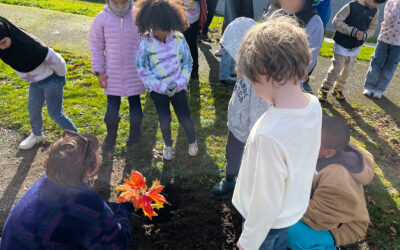The Bear at Walmart: an Authentic and Local Science Phenomena
“Waterfall waterfall, sssshhhhhh — Alright friends, we have been talking about habitats and what habitats are again.” Everyone chorally says while having their hands covering their head like a cave, where a plant or animal lives. “Good job, boys and girls, go ahead and kiss your brains. Please go ahead and tell your partner what animals would live in a forest habitat.” The students turn their bodies on the carpet from facing the whiteboard to now facing their peers. You can hear students’ voices uplifting the words bear, owl, squirrel, deer, skunk, bunny, and fox, even see them look over at the pictorial on habitats to see if they had mentioned them all as well as try to state them in both Spanish and English.
Today, we are going to learn about a particular animal whose habitat is the forest, the bear, particularly a black bear. ¨Have you ever heard about a bear that appeared at Walmart?” About half of my class hands went up enthusiastically, some not even waiting to be called on, saying “yo si, me, me, yo, yo.” Before they got too eager to talk to each other, I mentioned that I would show them a couple of videos of the bear from Walmart. You could hear the students start to quiet down until it was silent, with the exception of “maestra voy apagar la luz.” We watched a video of a report of the encounter with the bear at Walmart here in our very town of Yakima. This sparked conversation immediately with some students mentioning they saw it on their mom’s phone. I then showed my sister-in-law’s video of the bear moving near her apartment complex, where I also lived nearby. A bit hard to see but they were able to see the black bear running through the grass and climbing up to a tree. I mentioned to them that this was prior to the bear appearing at Walmart, but the same bear, since it was on the same day.

I then posed a question to them, ¨Why do you think the bear went to Walmart here in Yakima? Go ahead and talk with your partner about what you think, and then we can share our thoughts.” The sound of ideas starts pouring out from the students. I could hear it was hungry, it was looking for mom or baby, it got lost; those seemed to be the most prominent ideas from the students. These ideas were maintained on an anchor chart in the classroom, where all the students had the opportunity to refer back to.
Bear Habitats Model: Students’ Evolving Ideas
Over the next few lessons, we learned more about habitats and other animals whose habitat they shared with the bear. Over the course of drawing, dictation, and free writing, students adapted their bear habitats. At first, the majority of my students drew a bear and some trees. Others drew the same idea, but added a cave. As the unit progressed, more students added caves, and others started to add animals like butterflies, bunnies, and deer. Some added more vegetation other than trees such as grass, shrubs, flowers, and berries since they had learned that bears liked berries. There was a group of 3 students who drew a river and added fish such as salmon, depicting that as one of the bears’ forms of food. As their drawings started to acquire more details to depict their learning, they started reevaluating their thinking around the question of why the bear went to Walmart, leading into the next part in the unit.
Center on the Puzzling Phenomena: Fire, Trees, Human Impacts on Nature
“Rana rana, colita de rana. Alright class, we have made more discoveries about bears and their habitats. Since we have come across new learning, I want to go over our original question of why do you think the bear went to Walmart.” My students once again turned to their designated partner to share their ideas. From those conversations and walking around, I could hear the same ideas being mentioned, such as the bear is looking for food, but it now had more details, such as the bear is looking for berries or fruit in the tree. Some students mentioned that it was looking for fish. While I heard very similar ideas as before, I also heard different ideas when we shared them with the whole group. We came back, and some volunteered their ideas while I scribed on the previously made anchor chart. One of my students mentioned that maybe the bear went to Walmart because a fire had burned his home. Through this idea, I mentioned that in the fall we did have smoke outside and asked if they had remembered that. They quickly said, “Yes maestra si es cierto no podíamos ir outside.” Then another student wanted to share their idea, which was that maybe there were not enough trees, and they went to look for more. When I asked this particular student why there were not enough trees, he mentioned that we use trees for paper and cut them down. Another reason some other students shouted out was because of the fire maestra. That led to the conversation of human interaction with nature.
Humans’ Positive Impact to Safeguard our Coexistence
As they were focused on trees being cut down, they were upset with people for harming the trees of the bears. This was the moment where I decided to introduce students to how we humans can have a positive impact on the environment and change the concept of caring for animals from being dependent on us to caring for our coexistence together in the natural world. This is where animal crossings were introduced to my students as an example for them to see that there are changes humans can make in the environment to have a positive impact on animals and their habitats. My students were fascinated and wowed by what they saw. They saw an example of an animal crossing here on the I-90 Wildlife Bridge, and when the first bear was captured on video using the bridge, the student cheered with joy. ¨Mira es el oso, los osos si lo usan maestra* These were only part of the phrases that the students shouted out from excitement. The excitement grew even more when they saw more and more animals utilizing the bridge, especially when they saw a cougar. As my students continued to work with the idea of human impact, they revised their drawings of the bear’s habitat. The drawing of the habitat itself remained very similar to their previous one, but they all added a bridge indicating a connection of the animal crossing as well as a house with them there in the distance. This indicated a different form of relation to the bear, one where we co-exist with one another.





 This site is primarily funded by the National Science Foundation (NSF) through Award #1907471 and #1315995
This site is primarily funded by the National Science Foundation (NSF) through Award #1907471 and #1315995